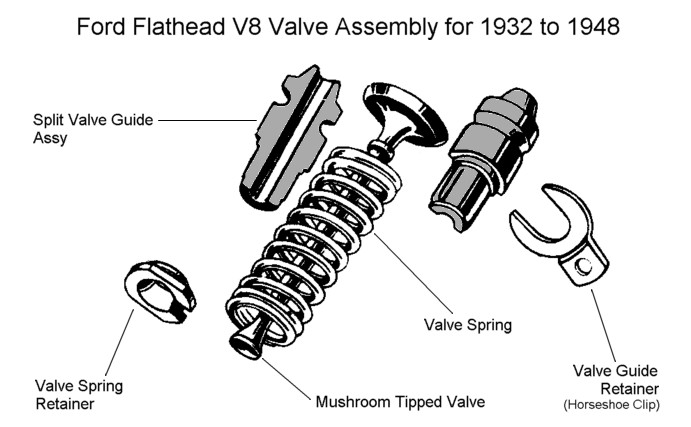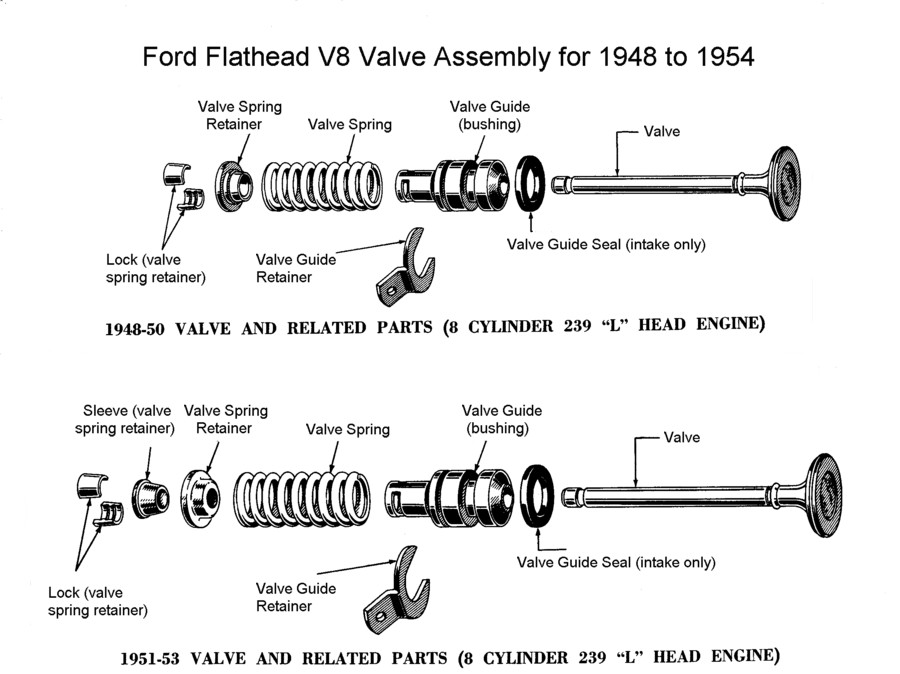|
Flathead Ford Valve Removal Tools |
||||
|
|
||||
|
Home Parts Drawings Web Links Tune-Up & Service Serial Numbers Engine ID Trans ID Model Identification Terms of Sale Contact Us Our Online Store Our Catalog |
How to Remove Those Stubborn Valves and Valve Guides | |||
|
The Ford flathead V8 engines produced from 1932 to 1954 were designed with removable valve guides, which sat in machined bores in the block, alongside the cylinders. The valve, valve spring, valve keepers, and the valve guide were intended to be installed and removed as a single assembly. This assembly is held in place by the valve spring tension, and a steel retaining clip, which is commonly referred to as the "horseshoe clip" because of its general shape. The first drawings below show the basic assemblies as used from 1932 to 1948, and the later style as used from 1948 through final production in 1953 (USA) and 1954 (Canada). Be sure to follow the links to Page 2 and Page 3 on this subject. The original style used a split (two piece) valve guide and the valve had a mushroom tipped stem. The later design used a one-piece valve guide and a straight valve stem. It is not unusual to see the later style valve assembly used with rebuilds of the 1932 to 1948 engines, since they interchange and the late style assembly is generally easier to remove. For information on purchasing the valve guide bar tool click here Note: Except for the valve guide bar tool, we do not sell any of the other valve tools pictured or described in the following tech articles about valve removal or installation. The tools pictured were manufactured many years ago and have not been produced in recent years. You can sometimes find the older tools at swap meets or vendors who specialize in the old tools or in other online shopping venues. |
||||
|
|
||||
|
The original style valve with the mushroom tip will not pull out of the valve guide due to the large end. The valve and guide assembly must be removed as a unit in order to allow the split guide to come apart and remove the valve. Some mechanics have, after removing the valve spring and retainer, cut the valve stem in two, allowing the valve to be removed from above and below. The general procedure for this is to:
Unless the engine is to be totally rebuilt and the block cleaned, you may not want bits and shavings of metal to drop into the valve galley. So, it is usually recommended that you remove the assembly (taking it out the top of the block) before further disassembly can be done. Unfortunately, most of these old flathead V8's were run years ago with non-detergent oils and heat and other corrosion tended to make the valve guides stick into the guide bores. Since you don't know how much wear has occurred in the valve guides, it's generally a good idea to replace them, as well as the valves and all the related hardware.
|
||||
|
|
||||
|
The late style valve can be removed easily from above, once the valve spring retainer & lock are removed. The valve guides on these and the early style engines can still be difficult to remove. Old, dirty engine oil has often varnished and baked the valve guide into the bore and they become stuck. Soaking all the valve parts in advance with a penetrant will often help with the disassembly. Frequently used is diesel fuel, brake fluid, automatic transmission fluid, or other fluids that will penetrate into the tight clearances. Refer to the following web page for pictures of common tools used by mechanics to aid in valve removal in the Ford and Mercury flathead V8 engines. |
||||


